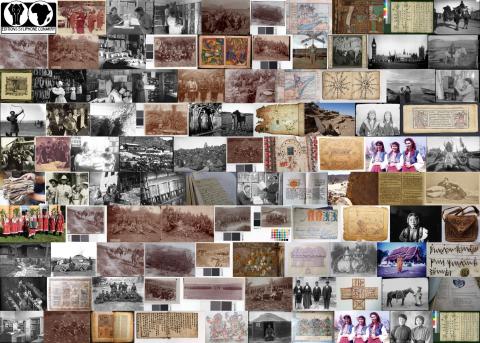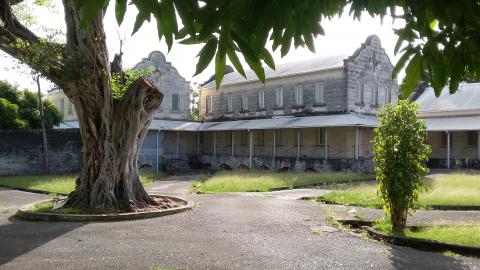
Aims and objectives
This research is a continuation of the earlier pilot project EAP093. It will concentrate on the digitisation of historic documents held on the Caribbean island of Nevis. These manuscript records date from between 1705 and c. 1920, and provide a vital insight into the island’s social and economic history, during both its slavery and post-slavery eras. 170 volumes will be digitised.
Nevis was one of the earliest and richest of the British West Indian sugar islands. In the 18th century there were up to 10,000 slaves of African origin working on over 100 estates. Their modern descendants have only a generalised grasp of the history of Nevis, and over time their sense of that history is being lost, particularly due to continued emigration. In this scenario the written records with which we are concerned are just as significant for local Nevisians as they are to regional and international historians.
Although there are important Nevisian records held in the UK National Archives and in the government archive at St Kitts, the principal sources for Nevis’ history are held on the island itself, mainly in the Supreme Court Registry and the Registrar General’s Office. These are crucial, endangered documents, and the information they contain is replicated nowhere else.
This project will focus on records dating between 1705 and 1920. It is proposed that all historic documents in the Supreme Court House vault will be digitised and a selective, early series of volumes from the Registrar General’s Office (of 19th-century date) will also be digitised. In total the digitisation of 170 volumes is envisaged.
As a whole, these documents elucidate, for a period of over two centuries, the complex economic and social interactions of Nevisian society. They also record the difficult process of the development of an independent, small-scale economy in the post-Emancipation era. The records preserve much micro-historical detail: for example, they commonly list the age, health, monetary value, occupations and family relationships of enslaved people. Similarly, estate plans potentially provide locations for lost slave and post-Emancipation villages. This is not only intrinsically valuable archaeological data, but may also inform planning decisions on an island whose economy is geared to tourism-based development. These documents complement other regional collections of similar character, including those for St Vincent, Grenada and Anguilla, which have been the subject of EAP projects.
Nevis’ historical resource has diminished over time, due to natural disasters and human actions, as illustrated by the following chronology:
- 1706 French invasion: records burned in the street
- 1837 Fire in Charlestown destroys the Court House
- 1873 Court House fire
- 1882 Nevis and St Kitts united in one Presidency: Nevis records transhipped to St Kitts
- 1982 Court House fire in St Kitts: Nevis records burnt
- 2014 Fire in Nevis Treasury
The surviving records, on which this project focuses, are at risk of similar total or piecemeal destruction.
The project will preserve the information contained within these documents through a programme of digital photography. In addition the project will purchase archival storage boxes to improve the storage conditions of the records, even if they stay in their present location.
Through employment of local staff, the project aims to leave a legacy of digitisation- and heritage-related skills on Nevis. Engagement with government, schools, NHCS and the wider public is also seen as integral to encouraging the use, and appreciation of, this important resource.
Outcomes
The project's principal focus was on records dating between 1705 and the end of the 19th century. Several volumes containing 20th-century material were also included, predominantly those which spanned both the 19th and 20th century or which were indexes. All historic documents found in the Eastern Caribbean Supreme Court building’s vault were digitised, together with three volumes held in the adjacent Registry office. The exceptions are the following volumes, which were too fragile to be photographed without causing an unacceptable level of damage. It is also questionable whether there remains enough legible material within these volumes to make either their digitisation or preservation worthwhile. These comprised:
• Common Deed Record Book 1707-1728
• Kings Bench and Common Pleas 1718-1723.
In the project application for EAP 794, a selective early series of volumes from the Registrar General’s Office was within the scope. However, when the project commenced it was found that these materials were already being digitised by an Organisation of American States-sponsored project based in St Kitts: as a result they were omitted from the final project scope. The following series were digitised:
•Common Deed Record Books, 1707-1956 (49 volumes)
• Court of King’s/Queen’s Bench and Common Pleas, 1705-1873 (39 volumes)
• Supreme Court, 1874-1962 (9 volumes)
• Other Courts, 1815-1943 (8 volumes)
• Wills, 1763-1880 (7 volumes)
• Ships Bonds, 1847-1867 (7 volumes)
• Provost Marshal’s Sales, 1847-1935 (9 volumes)
• Land Title Register Books, 1887-1922 (3 volumes)
• Miscellaneous Records, 1840-1940 (23 volumes)
• Maps and plans, 1888-1974 (205 individual maps/plans, or montages of plans)
COURT HOUSE VAULT
At the time of EAP093 (in 2008), the historic records were held in a disordered state inside a small vault within the courthouse building. Wooden shelves were present, but were not adequate for all the volumes, meaning that many were jammed into any available space, or stacked on top of each other. The historic records shared space with modern legal records, again kept on shelves or on the floor in disorganized cardboard boxes and sometimes loose in piles. Environmental conditions of storage (dusty, humid) were poor.
The severe lack of space within the vault, combined with the regular searches for modern documents by court staff, caused a continual shuffling of the vault’s contents. Over time there has been appreciable accidental damage to the historic volumes, while any ordering of the collection was nearly impossible and public access was impractical.
The situation observed in 2008, and reported on in EAP093, remained the same when the vault was inspected in 2013 (by Andrew Pearson) and when EAP794 commenced in 2016.
The situation reported on in 2008 was brought to the attention of the Assistant Registrar, Melissa Flemming, and, with the help and enthusiasm of Wakely Daniel and Kevin Barrett of the Premier’s Ministry, assistance was sought from the Prison Farm. Prisoners were brought in and in two days they completely transformed conditions in the vault. Over the course of the EAP project, the situation relating to the vault has changed as follows:
• With the amount of space available in the vault, boxing volumes was impractical and, before the prison team arrived, all the historic volumes had been rewrapped and tied up
• Where possible, to save space, smaller volumes were placed in banker’s boxes
• Some of the fragile volumes were placed in a tin box for safe keeping
• A more accurate handlist of the records was drawn up
• The prisoners then completely re-organized the vault, removing many of the modern records for storage elsewhere, recreating a system of storage for a much-reduced number of loose bundles of papers and cleaning the space. In the process, a number of volumes or items were re-discovered which had been lost for twenty years.
The Assistant Registrar has now taken full charge of the vault.
The project also submitted a detailed project report.
The records copied by this project have been catalogued as:
The volume Common Deed Record Books – CDRB 1707-1728 was too fragile to digitise as part of EAP794. Professor Roger Leech of Southampton University had digitised the item 12 years prior to this project and has kindly made his own photographs available for research purposes. The volume can now be downloaded as a PDFs from Google Drive by clicking on this link.



